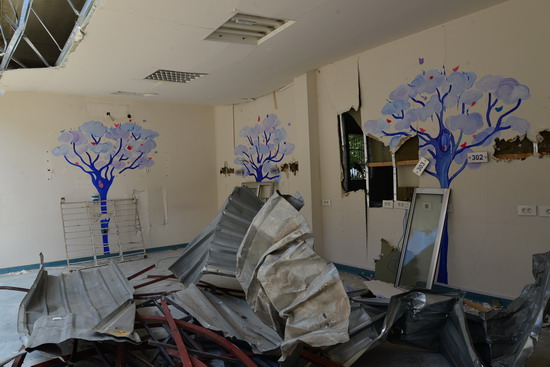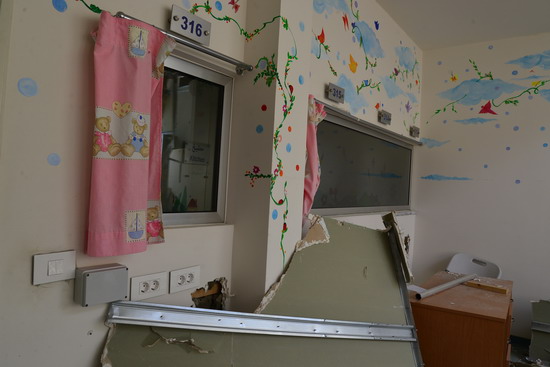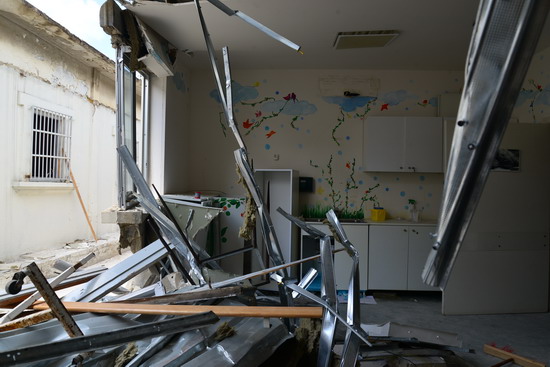
23 August 2020 – Two weeks after the explosion that damaged several areas of Beirut, Qaratina Public Hospital is still reeling from the damage. The hospital is located a few hundred metres from the epicentre of the blast and is one of 3 hospitals in the area that were totally destroyed.
A post-disaster rapid hospital assessment conducted by WHO found 80% of the hospital’s old building to be severely damaged and the structure unsafe as a result of the explosion; 30% of the hospital’s new building also sustained damage.
Before the blast, Qarantina hospital was known to be a hospital for the poor, providing medical care for families who had no insurance or social security and who could not afford private care. No one was turned away. As one of the few public hospitals in Lebanon that had a neonatal intensive care unit, it also served people coming from many areas outside Beirut.
At the time of the blast, Qarantina hospital’s paediatric section housed 8 newborns in the neonatal intensive care unit, which cares for babies who are either born prematurely and need special incubator care, or babies who have weak organs and cannot leave the hospital without special care.
 “Our only concern was to evacuate the babies,” said Fatima Ghader, paediatric Head Nurse, recalling the time of the blast. “We created a human chain to get the babies out of the hospital and to safety as fast as we could.”
“Our only concern was to evacuate the babies,” said Fatima Ghader, paediatric Head Nurse, recalling the time of the blast. “We created a human chain to get the babies out of the hospital and to safety as fast as we could.”
The outer walls of the neonatal intensive care unit and paediatric floor of the hospital were completely damaged, and many of the rooms housing incubators were badly affected. Thankfully, however, no babies were killed or injured. “The incubators are made from very thick sturdy plexiglass and that protected the babies from the falling debris,” added Nurse Ghader.

“Our first reaction was to grab the babies and run out to safety with them,” said Nurse Fatme Missilmani who has been with the hospital for 11 years. “My colleagues were bloodied and hurt. My leg was badly bruised. But our main concern was to get the children out to safety. I carried 2 babies and a colleague of mine carried 3 in her arms, and we made sure they were taken out of the building as quickly as possible.”
One 4-month old baby was undergoing surgery for pyloric stenosis in the operating room at the time of the blast. When the doctors heard the sound of the explosion and the lights went out, they covered him with their bodies to protect him, and used the light from their mobile phones to suture his wound before he was transferred to another hospital in Beqaa, where the operation was successfully completed.
As she walks through the hospital’s corridors, surrounded by broken windows, twisted metal structures and broken light bulbs dangling from the exposed ceilings, Nurse Missilmani is joined by other health staff, many of them still in shock at the state of the hospital, and moving around as if lost in strange territory. These were part of the nursing team who were well enough to report to work.
“I was on my way to the hospital to start my night shift when the blast happened,” said Ahmed Tofaileh, emergency room nursing supervisor. “The roads were in chaos, but I continued to the hospital to see what happened and to help. When I arrived, I headed straight to the paediatric section as I knew we had babies on respirators and in incubators that needed to be moved to other hospitals immediately. On my way in, I saw a mother carrying her baby who had been in intensive care. She thought he was still alive, but he had died just at the same time as the explosion. He had been very weak, and his chances of survival were slim. I told the mother and she broke down as I covered the baby’s face with a cloth and informed the ambulance staff.”
Hospital staff are now worried that they may lose their jobs if the hospital is not restored soon, but they are more worried about the impact the hospital’s closure has on the people who need its services. “As a public hospital, we should not be the last to receive funding. That is not fair to the staff, or to the poor families that depend on us for their babies to survive,” said Nurse Missilmani.
Due to the severity of the damage, the WHO assessment team, consisting of a nurse, a civil engineer, a biomedical engineer, and a medical doctor, recommended that the old building should be demolished, and that a new building should be constructed and renovated to serve as the main hospital at a total cost of US$ 9.5 million.







